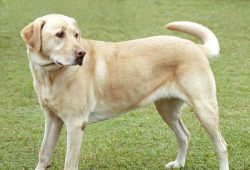The Labrador Retriever, also Labrador, is a type of retriever-gun dog. The Labrador is one of the most popular breeds of dog in the United Kingdom and the United States.
A favourite disability assistance breed in many countries, Labradors are frequently trained to aid the blind, those who have autism, to act as a therapy dog and perform screening and detection work for law enforcement and other official agencies. They are prized as sporting and hunting dogs.
Description
Appearance
Labradors are medium-large, with males typically weighing 65–80 lb (29–36 kg) and females 55–70 lb (25–32 kg). The majority of the characteristics of this breed, with the exception of colour, are the result of breeding to produce a working retriever.
Official breed standards
There is a great deal of variety among Labradors. The following characteristics are typical of the conformation show bred (bench-bred) lines of this breed in the United States and are based on the American Kennel Club standard. Significant differences between UK and US standards are noted.
- Size: Labradors are a medium-large breed. They should be as long from the withers to the base of the tail as they are from the floor to the withers. The AKC standard includes an ideal weight for males of 65–80 lb (29–36 kg) and for females as 55–70 lb (25–32 kg).
- Coat: The Labrador Retriever’s coat should be short and dense, but not wiry. The coat is water-resistant, so the dog does not get cold when taking to water in the winter. That means that the dog naturally has a slightly dry, oily coat. Acceptable colours are black, yellow, and chocolate.
- Head: The head should be broad with slightly pronounced eyebrows. The eyes should be kind and expressive. Appropriate eye colours are brown and hazel. The lining around the eyes should be black. The ears should hang close to the head and set slightly above the eyes.
- Jaws: The jaws should be strong and powerful. The muzzle should be of medium length and should not be too tapered. The jaws should hang slightly and curve gracefully back.
- Body: The body should have a powerful and muscular build.
The tail and coat are designated “distinctive [or distinguishing] features” of the Labrador by both the Kennel Club and AKC. The AKC adds that “true Labrador Retriever temperament is as much a hallmark of the breed as the ‘otter’ tail.”
Temperament
The AKC describes the Labrador’s temperament as a kind, pleasant, outgoing and tractable nature. Labradors’ sense of smell allows them to home in on almost any scent and follow the path of its origin. They generally stay on the scent until they find it. Navies, military forces and police forces use them as detection dogs to track down smugglers, thieves, terrorists and black marketers. Labradors instinctively enjoy holding objects and even hands or arms in their mouths, which they can do with great gentleness (a Labrador can carry an egg in its mouth without breaking it). They are known to have a very soft feel to the mouth, as a result of being bred to retrieve game such as waterfowl. They are prone to chewing objects (though they can be trained to abandon this behavior). The Labrador Retriever’s coat repels water to some extent, thus facilitating the extensive use of the dog in waterfowl hunting.
Labradors have a reputation as a very even-tempered breed and an excellent family dog. This includes a good reputation with children of all ages and other animals. Some lines, particularly those that have continued to be bred specifically for their skills at working in the field (rather than for their appearance), are particularly fast and athletic. Their fun-loving boisterousness and lack of fear may require training and firm handling at times to ensure it does not get out of hand—an uncontrolled adult can be quite problematic. Females may be slightly more independent than males. Labradors mature at around three years of age; before this time they can have a significant degree of puppy-like energy, often mislabelled as being hyperactive. Because of their enthusiasm, leash-training early on is suggested to prevent pulling when full-grown. Labradors often enjoy retrieving a ball endlessly (often obsessively) and other forms of activity (such as agility, frisbee, or flyball).
Health
In 2014, the UK breed survey reported an average lifespan for the Labrador Retriever of 12 years and 3 months, with some living up to 19 years of age. Labrador pups generally are not brought to the home before they are 8 weeks old.
It is a healthy breed with relatively few major problems. Notable issues related to health and well-being include inherited disorders and obesity.
Labrador Retriever. (2017, June 22). In Wikipedia, The Free Encyclopedia. Retrieved from https://en.wikipedia.org/w/index.php?title=Labrador_Retriever&oldid=787016813


